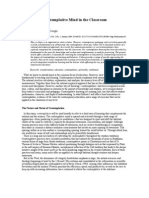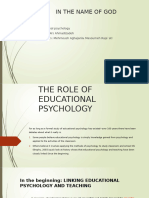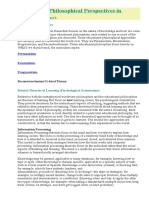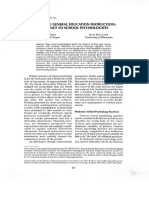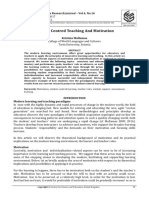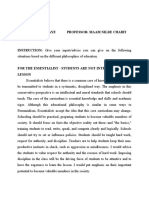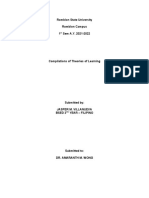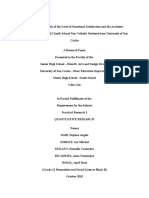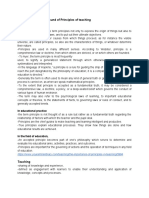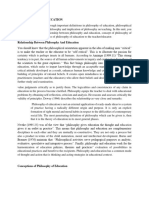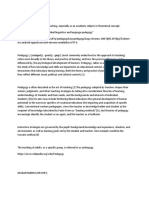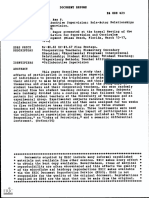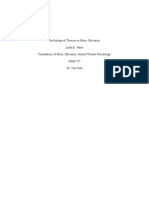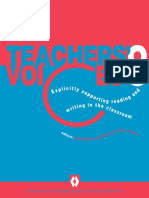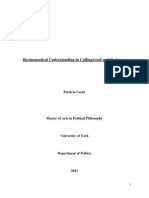Factors Affecting Public High School Students Towards Philippine Power Point
Factors Affecting Public High School Students Towards Philippine Power Point
Uploaded by
Jamerz Luvz UCopyright:
Available Formats
Factors Affecting Public High School Students Towards Philippine Power Point
Factors Affecting Public High School Students Towards Philippine Power Point
Uploaded by
Jamerz Luvz UCopyright
Available Formats
Share this document
Did you find this document useful?
Is this content inappropriate?
Copyright:
Available Formats
Factors Affecting Public High School Students Towards Philippine Power Point
Factors Affecting Public High School Students Towards Philippine Power Point
Uploaded by
Jamerz Luvz UCopyright:
Available Formats
FACTORS AFFECTING PUBLIC HIGH SCHOOL STUDENTS TOWARDS PHILIPPINE FOLK DANCE
4/28/12
RATIONALE
Dance is an expression of an intensified sense of arising from an inner perception that stimulates both mind and body. It is man's natural and primitive means of expression that truest expression of a people. Is in its dances and its music. The body never lies. has been part of the
4/28/12
Dance
A dance is simply emotional expression when develop into
7 a design with its planned organization of a pattern of
movement in rhythm, in space, and on ground, with its set of steps, gestures and dynamics becomes a specific dance. And when stylized in a common design becomes a dance form. These dance forms which takes centuries to develop; reflect the customs of the society in which they have evolved. When
Click to edit Master tribesmen wanted something, they dance for it. They dance subtitle style
to call the rain spirit to send rain for their crops; they dance to heal the sick; they dance to show off their affection to someone; when they are victorious after a battle they would 4/28/12 feast and dance. Indeed, the body is the basic instrument of life.
The Philippine dance should be seen at an angle wherein it will be reflective of a natural culture identity and that will mirror the Filipino psyche and aspirations.
As an expressive folk art, it depicts the nations sentiments and creative spirit. It exemplifies vicissitudes of Filipino life through the centuries. It is the Filipino expression of his faith, joys, sorrows, hopes, and aspirations. It is the Filipino soul who speaks straight from his heart.
4/28/12
Dance research in the Philippines was initiated at the University of the Philippines, when the former UP President, Jeorge Bocobo requested Francisca Reyes to present a repertoire of folk dances. This then put the people involved to be aware that there was a lack of recorded and documented fold dances. Thus years of long research work started.
Folk Dances, in the purest form, is too pouring to interest the audience. The principle behind is to adapt these indigenous dances to the conventions and possibilities of modern theatre. This principle would then satisfy the need to situate the dances within their cultural context. In designing them one should keep the
4/28/12
It is a fact that in most schools program, Physical Education is not given as much time as the academic subject and is an often neglected especially Philippine folk dance subject. There are some factors that affects public high school students attitudes (Leslie W. Irwin, the Curriculum in Health (St. Louis: The C.V Mosby Co., 1951) and performance rating towards that subject in particular. A common assumption of the general public is that students take Physical Education because it is requirement for graduation. Furthermore, absences and drop outs are very common in the Physical Education subject. This has become a problem of the teachers and administrators in many schools. This assumption has prompted and researchers curiosity to find out the factors that affects public high school students towards Philippine folk dance class particularly of the Don Vicente Rama National High School and Abellana National High 4/28/12 School.
THEORETICAL BACKGROUND
4/28/12
This study is anchored mainly on the following theories:
The Theory of students Involvement by Alexander W. Astin, The theory of The Stimulus-Response Theory (Associative Theory) by Edward Thorndike. The theory of The Cognitive Theory of Learning (Field Theory) by Max Wertheimer.
4/28/12
The Theory of students Involvement by Alexander W. Astin
It provides a link between the variables emphasized in these theories (subject matter, resources, and individualization of approach) and the learning outcomes desired by the student and the professor. In other words, the theory of student involvement argues that a particular curriculum, to achieve the effects intended, must elicit sufficient student effort and investment of energy to bring about the desired learning and development.
4/28/12
Simply exposing the student to a particular set of courses may or may not work. The theory of involvement, in other words, provides a conceptual substitute for the black box that is implicit in the three traditional pedagogical theories. The content theory, in particular, tends to place students in a passive role as recipients of information. The theory of involvement, on the other hand, emphasizes active participation of the student in the learning process. Recent research at the pre- collegiate level (Rosenshine, 1982) has suggested that learning will be greatest when the learning environment is structured to encourage active participation by the student.
4/28/12
On a more subtle level, the theory of student involvement encourages educators to focus less on what they do and more on what the student does: how motivated the student is and how much time and energy the student devotes to the learning process. The theory assumes that student learning and development will not be impressive if educators focus most of their attention on course content, teaching techniques, laboratories, books, and other resources. With this approach, student involvementrather than the resources or techniques typically used by educators becomes the focus of concern.
4/28/12
Thus, the construct of student involvement in certain respects resembles a more common construct in psychology: motivation. They prefer the term involvement, however, because it implies more than just a psychological state; it connotes the behavioural manifestation of that state. Involvement, in other words, is more susceptible to direct observation and measurement than is the more abstract psychological construct of motivation. Moreover, involvement seems to be a more useful construct for educational practitioners. How do you motivate students? is probably a more difficult question to answer than How do you get students involved?
4/28/12
The theory of student involvement is qualitatively different from the developmental theories that have received so much attention in the literature of higher education during the past few years. These theories are of at least two types: those that postulate a series of hierarchically arranged developmental stages (e.g., Heath, 1968; Kohlberg, 1971; Loevinger, 1966; Perry, 1970) and those that view student development in multidimensional terms (e.g., Brown & DeCoster,1982; Chickering, 1969). (For recent, comprehensive summaries of these theories see Chickering & Associates, 1981; Hanson, 1982.).
4/28/12
Whereas these theories focus primarily on developmental outcomes (what of student development), the theory of student involvement is more concerned with the behavioural mechanisms or processes that facilitate student development (the how of student development). These two types of theories can be studied simultaneously.
4/28/12
The Stimulus-Response Theory (Associative Theory) by Edward Thorndike
The stimulus-response (S-R) theory developed by Edward Thorndike suggests that learning takes place by conditioning a response to a stimulus. Learning is associating and conditioning. Learning takes place with an established neural pathway between the stimulus and the response. This theory emphasized that when an individual is stimulated to perform an act of response and this act or response is accompanied by pleasure or satisfaction, he will remember and repeat the act. Then with practice, the response becomes automatic like any other drill or habit.
4/28/12
In physical education, the S-R theory favours teaching of an activity or skill and providing the opportunity to practice correctly until the skill is learned or mastered. It is the responsibility of the physical education teacher when teaching a skill to provide the best possible demonstration of the skill to be learned, and to continually assist the learner in the practice using the technique to assure improved.
4/28/12
The Cognitive Theory of Learning (Field Theory) by Max Wertheimerlearning which The cognitive theory of
has been developed by Gestalt `focuses on the individual. It states that an individual learns a task as a meaningful whole rather than a series of related parts. It proposes that the response is not to the stimulus but to the learners perception of the reconstruction of the stimulus in terms of the whole situation. An outstanding advocate of the cognitive theory is Jerome Bruner. His major emphasis is on the discovery approach which gives much
4/28/12
In the Social Cognitive Theory, we are considering 3 variables:
behavioural factors
environmental factors (extrinsic)
personal factors (intrinsic)
4/28/12
These 3 variables in Social Cognitive Theory are said to be interrelated with each other, causing learning to occur. An individuals personal experience can converge with the behavioural determinants and the environmental factors.
4/28/12
In the person-environment interaction, human beliefs, ideas and cognitive competencies are modified by external factors such as a supportive parent, stressful environment or a hot climate. In the person-behaviour interaction, the cognitive processes of a person affect his behaviour; likewise, performance of such behaviour can modify the way he thinks. Lastly, the environmentbehaviour interaction, external factors can alter the way you display the behaviour. Also, your behaviour can affect and modify your environment. This model clearly implies that for effective and positive learning to occur an individual should have positive personal characteristics, exhibit appropriate behaviour and stay in a supportive environment.
4/28/12
In addition, Social Cognitive Theory states that new experiences are to be evaluated by the learner by means of analyzing his past experiences with the same determinants. Learning, therefore, is a result of a thorough evaluation of the present experience versus the past. For the purpose, the school will design a development program for the Physical Education student. Prior to decision-making on the form of development program for the student, an identification of the development need is in order. This is possible through curriculum research and curriculum evaluation. Hence,
4/28/12
The present study will attempt to improve the curriculum in physical education specifically the Philippine folk dance program for the public high school Physical Education students that will meet the need of the clientele.
4/28/12
SIGNIFICANCE OF THE STUDY
4/28/12
the factors affecting public high school students towards Philippine Folk Dance
The findings of this research would serve veritable information to the following:
4/28/12
To the Students.
They are the learners of the school. The study is significant to the degree that the factors affecting public high school students towards Philippine folk dance will serve as a baseline in applying modern techniques in the teaching of Philippine folk dance in public high school students.
4/28/12
To the Parents.
Information given in this study would help them motivate their students to develop good behaviour and to make them aware of our culture
4/28/12
To the P.E. Instructors.
The results of this study would help the P.E. teachers to understand the process of developing knowledge, skills, habits, interest, attitude, factors that affects the public high school students towards Philippine folk dance so as to improve in the teachinglearning process.
4/28/12
To the School Administrators.
The information given on this research would make them aware of the importance of considering interest, attitude, and factors that affects the students towards Philippine folk dance and if schools aimed to promote and maintain quality, the administrator can give their support in terms of hiring physical education teachers who can really deliver the goods in terms of knowledge, skills, habits and expertise in Philippine folk dance.
4/28/12
To the Researchers.
These people are the ones who are in direct contact with the respondent.
4/28/12
4/28/12
You might also like
- Martin P Human Nature RelationshipsDocument15 pagesMartin P Human Nature RelationshipsAbdul RehmanNo ratings yet
- Leadership Course OutlineDocument3 pagesLeadership Course OutlineKashif Mahmood100% (2)
- The Stuff of Thought - Chapter 7 - The Seven Words You Can't Say On TelevisionDocument50 pagesThe Stuff of Thought - Chapter 7 - The Seven Words You Can't Say On TelevisionGabrielaSpinolaNo ratings yet
- 2004 - Hart - Opening The Contemplative Mind in The ClassroomDocument12 pages2004 - Hart - Opening The Contemplative Mind in The Classroometherealflames5228No ratings yet
- Supplementary Notes On Foundations of School CurriculumDocument15 pagesSupplementary Notes On Foundations of School CurriculumshainamariebertoNo ratings yet
- The Psychological Tendency in EducationDocument3 pagesThe Psychological Tendency in EducationEmerson67% (3)
- Scoping Review MethodologyDocument14 pagesScoping Review MethodologyANNA MARIE LARGADAS MALULANNo ratings yet
- Philosophical Foundations of Curriculum - NotesDocument6 pagesPhilosophical Foundations of Curriculum - NotesNoo BoddieNo ratings yet
- Assignment #7 - Dr. TotanesDocument3 pagesAssignment #7 - Dr. TotanesGeraldine MaeNo ratings yet
- Modern Methods and Material ScienceDocument1,119 pagesModern Methods and Material ScienceBint-e-QaiserNo ratings yet
- Physed ReflectionDocument9 pagesPhysed ReflectionAlex GreenNo ratings yet
- Facilitating LearningDocument32 pagesFacilitating LearningLaleth Mendoza OjalesNo ratings yet
- Adult Learning - Andragory and PedagogyDocument5 pagesAdult Learning - Andragory and PedagogyAkshay Samarth100% (1)
- Educational Psychology and Learning Theories Compulsory Reading Block 1 16-17Document11 pagesEducational Psychology and Learning Theories Compulsory Reading Block 1 16-17api-333286998No ratings yet
- The Role of Educational PsychologyDocument21 pagesThe Role of Educational PsychologyasalrezayiengNo ratings yet
- Section III - Philosophical Perspectives in Education: Educational PhilosophiesDocument3 pagesSection III - Philosophical Perspectives in Education: Educational PhilosophiesHarlyn GayomaNo ratings yet
- Lit ReviewDocument5 pagesLit Reviewapi-430633950No ratings yet
- Improving General Education Instruction: Relevance To Scho O L PsychologistsDocument21 pagesImproving General Education Instruction: Relevance To Scho O L PsychologistsIsabella Valentina Rodriguez AssouadNo ratings yet
- 3593-Article Text-9190-1-10-20170820Document14 pages3593-Article Text-9190-1-10-20170820Chaima GuezzziNo ratings yet
- Chapter 2Document43 pagesChapter 2api-59037670No ratings yet
- 2nd Activity Maam ChabitDocument5 pages2nd Activity Maam ChabitJalefaye Talledo Abapo100% (1)
- Psychological Foundation of Education in PakistanDocument10 pagesPsychological Foundation of Education in Pakistansanamehar97No ratings yet
- Sensory Stimulation TheoryDocument5 pagesSensory Stimulation TheoryVikas ChaudharyNo ratings yet
- Interaction Ritual Approaches To The Study of Emotion in Science Education - BellocchiDocument23 pagesInteraction Ritual Approaches To The Study of Emotion in Science Education - BellocchiSHAAKIRAH GOOLAMNo ratings yet
- Motivation DM MLPC ElenaDocument44 pagesMotivation DM MLPC ElenaNikkiNo ratings yet
- Educ 4Document7 pagesEduc 4Renzo R PornillosNo ratings yet
- CHAPTER 1 - Modu-WPS OfficeDocument17 pagesCHAPTER 1 - Modu-WPS OfficePatricia Geroy100% (1)
- Teaching and Development From Nakkula and Toshalis' "Understanding Youth"Document9 pagesTeaching and Development From Nakkula and Toshalis' "Understanding Youth"Jonathan LyonsNo ratings yet
- Compilation of TheoriesDocument15 pagesCompilation of TheoriesQuenie De la Cruz100% (2)
- A Correlational Study of The Level of Emotional Satisfaction and The Academic Performance of Grade South School NonCatholic Students From University of San CarlosDocument29 pagesA Correlational Study of The Level of Emotional Satisfaction and The Academic Performance of Grade South School NonCatholic Students From University of San CarlosIan Mitchel EmbateNo ratings yet
- Group1 Detailed ReportDocument13 pagesGroup1 Detailed ReportKristine Joy MacabingkelNo ratings yet
- Philosophy and Education NotesDocument22 pagesPhilosophy and Education Noteslukeisah1234No ratings yet
- Classical ConditioningDocument17 pagesClassical ConditioningRyan Iraola100% (1)
- file:///C:/Users/Aspire-3/Downloads/ The - Interpersonal - Intelligence - Profile - of - Seventh PDFDocument7 pagesfile:///C:/Users/Aspire-3/Downloads/ The - Interpersonal - Intelligence - Profile - of - Seventh PDFAIVA MAY CUABONo ratings yet
- Learning TheoriesDocument4 pagesLearning TheoriesJay Karta0% (1)
- Foundation of EducationDocument54 pagesFoundation of Educationdavid john ubera100% (1)
- Pedagogical Learning ApproachDocument10 pagesPedagogical Learning ApproachDj PadillaNo ratings yet
- Learning StrategiesDocument27 pagesLearning StrategieskhoerumanNo ratings yet
- Chapter 1 Students Copy UnillustratedDocument8 pagesChapter 1 Students Copy Unillustratedsharapedro4No ratings yet
- M.ED AssignmentDocument15 pagesM.ED AssignmentGhazal MunirNo ratings yet
- Sustainability 09 00750Document13 pagesSustainability 09 00750Subhas RoyNo ratings yet
- ED125102Document15 pagesED125102Shari Ann DatahanNo ratings yet
- Understand TermodinamicsDocument62 pagesUnderstand TermodinamicsmatematicasyfisicaclassNo ratings yet
- Source 3Document18 pagesSource 3api-447689377No ratings yet
- Educational PhilosophiesDocument3 pagesEducational PhilosophiesDanielle AkutagawaNo ratings yet
- The Impact of The Learning Environment On Student Engagement in High School ClassroomsDocument12 pagesThe Impact of The Learning Environment On Student Engagement in High School ClassroomsemysamehNo ratings yet
- Principles of BehaviorismDocument4 pagesPrinciples of BehaviorismKen Chai NgNo ratings yet
- Psychological Theories in Music EducationDocument6 pagesPsychological Theories in Music Educationapi-534592269No ratings yet
- Principles of InstructionDocument5 pagesPrinciples of InstructionBhelle ToyaoNo ratings yet
- Castro Literature ReviewDocument6 pagesCastro Literature Reviewapi-419554205No ratings yet
- Bronfenbrenner - ReviewDocument5 pagesBronfenbrenner - ReviewBrittany Caroline BlackNo ratings yet
- Constructivist Learning Theories and Complex Learning EnvironmentsDocument13 pagesConstructivist Learning Theories and Complex Learning Environmentsnad791No ratings yet
- Experiential LearningDocument11 pagesExperiential LearningAndrea BertocchiNo ratings yet
- The Teacher and The School Curriculum Module 2 2Document3 pagesThe Teacher and The School Curriculum Module 2 2Kiana PanganNo ratings yet
- Criticalaction Are6641 NyhagenDocument12 pagesCriticalaction Are6641 Nyhagenapi-253884078No ratings yet
- Dance Therapy As Treatment of Choice For The Emotionally Disturbed Learning Disabled ChildDocument4 pagesDance Therapy As Treatment of Choice For The Emotionally Disturbed Learning Disabled ChildCarl CannonNo ratings yet
- The Situational Interest of Undergraduate Students in ZoophysiologyDocument6 pagesThe Situational Interest of Undergraduate Students in ZoophysiologyAbdul Kadir BagisNo ratings yet
- The Role of Experience in Learning: Giving Meaning and Authenticity To The Learning Process in SchoolsDocument10 pagesThe Role of Experience in Learning: Giving Meaning and Authenticity To The Learning Process in SchoolsAhmed YusufNo ratings yet
- Final Paper 3000 1Document19 pagesFinal Paper 3000 1api-330206944No ratings yet
- Juntunen Ryhtme2019Document10 pagesJuntunen Ryhtme2019Ding SiweiNo ratings yet
- PSYCHOLOGY & SOCIAL PRACTICE – Premium Collection: The Logic of Human Mind, Self-Awareness & Way We Think (New Psychology, Human Nature and Conduct, Creative Intelligence, Theory of Emotion...) - New Psychology, Reflex Arc Concept, Infant Language & Social PsychologyFrom EverandPSYCHOLOGY & SOCIAL PRACTICE – Premium Collection: The Logic of Human Mind, Self-Awareness & Way We Think (New Psychology, Human Nature and Conduct, Creative Intelligence, Theory of Emotion...) - New Psychology, Reflex Arc Concept, Infant Language & Social PsychologyNo ratings yet
- MB0050 Research MythodologyDocument10 pagesMB0050 Research MythodologyHemant DalalNo ratings yet
- LeadershipDocument100 pagesLeadershipAnindya Vikram SinghNo ratings yet
- "Perception" Through Queen Movie: Roll No. NameDocument9 pages"Perception" Through Queen Movie: Roll No. NameAlankar DhuriNo ratings yet
- CS3243 Foundations of Artificial Intelligence: AY2003/2004 Semester 2 Introduction: Chapter 1Document13 pagesCS3243 Foundations of Artificial Intelligence: AY2003/2004 Semester 2 Introduction: Chapter 1Alysson NazarethNo ratings yet
- fs4 (Episode 6) PDFDocument7 pagesfs4 (Episode 6) PDFCes Reyes100% (8)
- Budgeted Lesson Plan in PhilosophyDocument4 pagesBudgeted Lesson Plan in PhilosophyAllize CatalanNo ratings yet
- ACT Science Section NotesDocument2 pagesACT Science Section NotesescalationsNo ratings yet
- Richard Rorty Intellectual Autobiography Schilp Volume PDFDocument13 pagesRichard Rorty Intellectual Autobiography Schilp Volume PDFMdmChghMhamdiDridiNo ratings yet
- PS 1 Fundamentals of Political ScienceDocument8 pagesPS 1 Fundamentals of Political ScienceMikaela Rome BigayNo ratings yet
- 2001 - Larsson - Problem-Based Learning - Apossible Approach To Language Education PBLDocument12 pages2001 - Larsson - Problem-Based Learning - Apossible Approach To Language Education PBLNilana Rodrigues de SouzaNo ratings yet
- Properties of A Well Written TextDocument37 pagesProperties of A Well Written TextDaneiru Miyazono100% (1)
- Introducing Philosophy Unit Plan 2 - 21st Century HappinessDocument105 pagesIntroducing Philosophy Unit Plan 2 - 21st Century Happinessapi-246557947No ratings yet
- PSSLC EnglishDocument82 pagesPSSLC EnglishKathleen Fhaye Escomiendo50% (4)
- Annotated Bibliographies For Weebly SamplesDocument2 pagesAnnotated Bibliographies For Weebly Samplesapi-247477832No ratings yet
- Gen Math 11 - 2ND Qtr-JuanpitDocument28 pagesGen Math 11 - 2ND Qtr-JuanpitBessai PalanasNo ratings yet
- Organizational BehaviorDocument348 pagesOrganizational Behaviorabhisheksood_89100% (1)
- Lessing FictionDocument4 pagesLessing FictionMaria LegedzaNo ratings yet
- Annotated BibliographyDocument3 pagesAnnotated Bibliographyapi-368273177No ratings yet
- Nguyen Phan Cam Tu (MS) - Le Quy Don Gifted School Email: Phone: 0914228228Document7 pagesNguyen Phan Cam Tu (MS) - Le Quy Don Gifted School Email: Phone: 0914228228Nguyen Phan Cam TuNo ratings yet
- Notes On Barrier of CommunicationDocument14 pagesNotes On Barrier of Communicationteenu2783% (6)
- How To Write An Editorial For A NewspaperDocument9 pagesHow To Write An Editorial For A NewspaperNelson VersozaNo ratings yet
- Prolog GamesDocument5 pagesProlog GamesRicardo Galvan ZNo ratings yet
- Instructional Supervision and Educational Administration. Goal SeDocument18 pagesInstructional Supervision and Educational Administration. Goal SeJeth NocomNo ratings yet
- Stylistics 2005Document376 pagesStylistics 2005anysweet92100% (5)
- The Self From The Anthropological: Chrishel Corsino, LPTDocument11 pagesThe Self From The Anthropological: Chrishel Corsino, LPTRamzen Raphael DomingoNo ratings yet
- Teachers Voices 8 PDFDocument85 pagesTeachers Voices 8 PDFaelphraedNo ratings yet
- Hermeneutical Understanding in Gadamer and CollingwoodDocument19 pagesHermeneutical Understanding in Gadamer and Collingwoodde-kNo ratings yet
- Implementing A CLIL Programme: Challenges and InitiativesDocument25 pagesImplementing A CLIL Programme: Challenges and Initiativesblgimeno5771No ratings yet



